With Hands-On Engineering Activities for Kids
Gadgets That Whiz, whoosh , Whirl, and twist
More engineering titles from Nomad Press

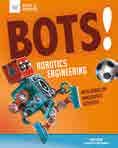
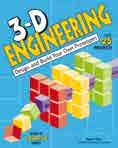

Check out more titles at www.nomadpress.net
Nomad Press
A division of Nomad Communications
10 9 8 7 6 5 4 3 2 1
Copyright © 2025 by Nomad Press. All rights reserved.
No part of this book may be reproduced in any form without permission in writing from the publisher, except by a reviewer who may quote brief passages in a review or for limited educational use. The trademark “Nomad Press” and the Nomad Press logo are trademarks of Nomad Communications, Inc.
This book was manufactured by Versa Press, East Peoria, Illinois 978-1-64741-143-5 September 2025, Job #J25-04634
ISBN Softcover: 978-1-64741-143-5
ISBN Hardcover: 978-1-64741-140-4
Educational Consultant, Marla Conn
Questions regarding the ordering of this book should be addressed to Nomad Press
PO Box 1036, Norwich, VT 05055 www.nomadpress.net
Printed in the United States
CONTENTS
Introduction Engineering at Play . . . 1
Chapter 1
Tension Time . . . 14
Chapter 2
Amazing Magnets . . . 28
Chapter 3
Get Going with Gears . . . 44
Chapter 4
What’s Up with Water? . . . 58
Chapter 5
Mad About Motors, Batteries, & Electricity . . . 72
Chapter 6
Counting on Chemical Reactions . . . 88
Glossary Resources
Selected Bibliography
Metric Conversions
Essential Questions
Index
Interested in primary sources?
Look for this icon.
Some of the QR codes in this book link to primary sources that offer firsthand information about the topic. Many photos are considered primary sources because a photograph takes a picture at the moment something happens—but watch out for fake ones! Use a smartphone or tablet to scan the QR code and explore more! You can find a list of the URLs in the Resources section. You can also use the suggested keywords to find other helpful sources.
engineering contraptions



Lever
A rigid bar or arm that pivots on a point called a fulcrum. It is used to move, launch, or lift an object.
Contraption Ideas:
Dominoes, catapult, popsicle sticks, pencils, seesaw
Inclined Plane
A sloped surface used to move an object up or down.
Contraption Ideas:
Book, racetrack, piece of cardboard, train track, ruler, toilet paper or paper towel tube, cereal box
Wheel and Axle
A wheel and a rod that rotate together when force is applied to one or the other. It is used to move objects.
Contraption Ideas:
Toy cars and trains, wheeled cart, built car
SIMPLE MACHINES
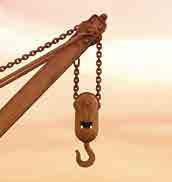

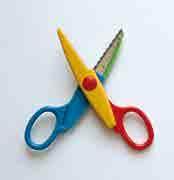
Pulley
A wheel with a grooved rim that guides a rope or chain to lift, lower, or move a load.
Contraption Ideas:
Pulley, zip line, rope slung over a fixed bar, rope threaded through a hook
Screw
An inclined plane wrapped around a central axis. It is used to lift and lower objects or hold them together.
Contraption Ideas:
Screw, spiral marble run, spiral slide, flexible tubing wrapped around a central axis, funnel, swirly straws
Wedge
An object that is thick at one end and narrows to a thin edge at the other, used to split, tighten, and lift objects.
Contraption Ideas:
Crafted wedge, doorstop, triangular-shaped blocks and other objects, thumb tacks, nails
ENGINEERING AT PLAY


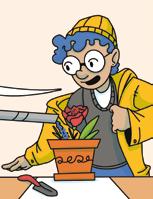
Is one of your chores at home to water the plants? Many people would fill the watering can and go straight to the plants to water them. Task completed in two simple steps!
But—maybe you find chores boring. Why not add a little fun? Instead of completing the task in two simple (and boring) steps, you could make the whole process way more complicated and ridiculous. In fact, you could create a whole contraption just to water the plants.
ESSENTIAL QUESTION
How does designing and building wacky contraptions use engineering principles?
If that sounds like fun, you are in the right place. This book is all about creating contraptions that involve a series of chain reactions to accomplish simple tasks in complex ways.
WACKY CONTRAPTIONS
WORDS TO KNOW
contraption: a machine or device that may seem unnecessarily complicated or strange.
chain reaction: a series of events in which one action causes the next one and so on.
engineer: a person who uses science, math, and creativity to design and build things.
engineering design process: the series of steps that guides engineering teams as they solve problems.
brainstorm: to think creatively and without judgment, often in a group of people.
physics: the science of how matter and energy work together.
matter: any material or substance that has mass and takes up space.
mass: the amount of matter or stuff in something. On Earth, the mass of something is very close to its weight.
energy: the ability to do work or cause change.
gravity: a force that pulls objects toward each other and all objects to the earth.
force: a push or pull that has the potential to change an object’s motion.
Watch this PBS DIY Science Time video to learn more about Newton’s laws of motion. How do Newton’s laws apply to seat belts? How does the mass of an object affect its acceleration?
THE ENGINEERING DESIGN PROCESS
To build wacky contraptions, it’s helpful to know how engineers go about designing and building things. Engineers use the engineering design process to plan and develop projects. Here are the steps in the engineering design process.
• Identify a challenge
• Brainstorm possible solutions
• Draw a plan
• Build the project
• Test it
• Evaluate it
• Redesign the project as needed
When building your contraptions, you will use the engineering design process, too. This will help you learn to think like an engineer. Plus, you’ll discover how each step in the process leads to a better contraption.
FEEL THE FORCE
When building contraptions, you need to know a little bit about physics , matter, and energy, including how and why objects move.
For that, we turn to an Englishman man named Sir Isaac Newton, who lived hundreds of years ago (1643–1727). Newton made a lot of contributions to mathematics and physics. He’s the one who discovered gravity. Technically, gravity was always around—Newton just identified it and figured out how it worked.
Another contribution was his three laws of motion. Newton’s laws of motion explain the relationships between objects and the forces that act on them. A force is a push or pull on an object. That’s what keeps an object in one place, moves it, speeds up its movement, slows it down, changes its shape, or changes its direction.

According to legend, Newton developed his theory of gravity after he observed an apple falling from a tree in the mid-1600s. He wondered why the apple moved straight downward instead of upward or sideways.
To better understand how forces work, think about a hockey stick. The stick is used to apply force to slow, stop, or increase the speed of a puck. Often, it’s used to change the direction in which the puck travels. Straight into the net!
Forces are all around us, even if we can’t see them. What keeps everything from floating away? Gravity! Gravity is a force that pulls objects toward the earth.
WACKY CONTRAPTIONS
WORDS TO KNOW
friction: a force that slows a moving object or objects when they move against each other.
tension: a pulling force that pulls or stretches an object.
spring force: a restoring force found in elastic materials that makes the material stretch or compress and then return to its original position when released.
electrical force: the push or pull between two electrically charged objects.
magnetic force: a force that occurs when the poles of a magnet interact.
magnet: a special kind of rock or metal that attracts certain metals.
air resistance: the force of air pushing against an object.
momentum: a measure of a mass in motion.
Friction , tension , and spring force are examples of forces, as are electrical and magnetic forces. We’ll explore all of these throughout this book.
Are you wondering why you need to know physics in order to build contraptions? Because you will need to understand how forces impact the objects in your contraption to maintain the chain reaction. This understanding will guide you as you design and redesign your contraptions.
FIRST LAW OF MOTION
Back to Sir Isaac and his three laws of motion. The first law of motion states that an object in motion will stay in motion (moving in the same direction and at the same speed) unless some force acts on it, and an object at rest will stay at rest for the same reason.
NEWTON’S FIRST LAW OF MOTION
An object in motion will stay in motion. An object at rest will stay at rest.
But an object doesn’t just keep moving forever and ever. Why? Forces! To better understand this, go get a ball of some kind—it doesn’t matter what size. Now, roll it along the floor. Eventually, it stops moving, doesn’t it? That’s because a force (or two) has acted on it.
Engineering Design Process
Every engineer keeps a notebook to record their ideas and their steps in the engineering design process. As you read through this book and do the activities, keep track of your observations, data, and designs in a design worksheet, like the one shown here. When doing an activity, remember there is no right answer or right way to approach a project. Be creative and have fun!
The Engineering Design Process
Air resistance is dragging on your ball, slowing its momentum. Friction acts on your ball, too. Friction occurs when two objects move against each other. In this case, the ball and floor are in contact, creating friction and slowing the ball.
If you had thrown the ball, there would be forces at work then, too— gravity and air resistance. It might seem hard to believe because air is invisible, but air does cause friction as an object moves through it.
WACKY CONTRAPTIONS
WORDS TO KNOW
newton (N): the unit used to measure force.
input force: the force applied to make an object move.
convoluted: complex and difficult to follow.
exert: to put forth effort or force.
Now, unless you go fetch that ball, it will stay where it landed. That’s the second part of the first law of motion. The ball will not move again unless another force acts on it. Maybe that force will be you or your friend or your sibling. Perhaps the neighborhood dog will come along and get that ball moving. You get the idea.
Forces are measured in units called newtons (N), named after Sir Isaac.
SECOND LAW OF MOTION
Newton’s second law of motion states that a push or pull on an object will change its speed—how quickly it moves. Plus, the amount of force needed to increase the speed of an object depends on its mass.
To demonstrate this second law, grab your ball again. Give it a little push. That small input force will move it slowly a short distance. Now, give the ball a bigger push. The larger input force moves the ball faster across a longer distance.
Let’s think about the second part of this second law. An object with more mass, such as a bowling ball, is harder to get moving. It is also harder to slow down. On the other hand, an object with less mass, such as a wiffle ball, requires less force to get it moving or to slow it down.
NEWTON’S SECOND LAW OF MOTION
A push or pull on an object will change its speed.
Who was Rube Goldberg?
Rube Goldberg (1883–1970) was an engineer and cartoonist. He became famous during the early 1900s for the cartoon drawings he made of ridiculous, convoluted contraptions. These contraptions accomplished simple tasks in overly complicated ways. One of his most famous contraptions was a self-operating napkin. He also invented a simple fly swatter, an automatic sheet music turner, a painless tooth-pulling device, and many others.
Each step in Goldberg’s drawings of chain reactions was lettered so people could follow the sequence of events. In addition, he included unusual parts in his contraptions, including rockets, fire, catapults, animals, springs, and pendulums. Goldberg never actually built any of his contraptions, but they were based on real engineering concepts and were designed to actually work if built. His real goal, though, was to make people laugh.
Visit the website of the Rube Goldberg Institute to learn more about Goldberg, the contraptions he designed, and ongoing design competitions. Why do you think Rube Goldberg contraptions are so popular?
THIRD LAW OF MOTION
Finally, the third law of motion states that for every action, there’s an equal and opposite reaction. It’s not always obvious, but forces occur in pairs—the action and the reaction. These two forces are the same size but move in opposite directions.
Grab your ball one more time. Go outside with it. Now, give it a kick. Your foot exerts an action force on the ball. At the same time, the ball exerts an equal and opposite reaction force on your foot. Feel it?
NEWTON’S THIRD LAW OF MOTION
For every action, there’s an equal and opposite reaction.
WACKY CONTRAPTIONS
WORDS TO KNOW
trial and error: trying first one thing, then another and another, until something works.
work: the amount of energy needed to move an object a certain distance.
potential energy: the energy stored inside an object when it is still or at rest.
kinetic energy: the energy an object possesses when it is in motion.
simple machine: a mechanical device that changes the direction or magnitude of a force. The six simple machines are the lever, inclined plane, wheel and axle, pulley, screw, and wedge.
mechanical advantage: the benefit gained by using a machine to do work with less effort.
You can really feel that force sometimes, especially if you’ve given the ball a good whack. That’s also why kickball is played with a light rubber ball. No one wants a reaction force exerted on their foot from a ball with a greater mass. Imagine how you’d feel if you kicked a bowling ball!
All of these laws of motion do not apply just to the ball you’re using. They apply to everything. For contraption building, you will use these laws of motion to figure out how to get things to slow down, speed up, and change direction.
WORK AND ENERGY
Another important part of contraption building is understanding that chain reactions are the result of energy transfers from one step to the next. This keeps the momentum going. Some of this you will learn firsthand through trial and error. That’s how all scientists approach tasks—they try and fail, then try again.
Energy is the ability to do work . Another way to think about energy is as the force that causes objects to move some distance. How much work is done depends on how much force is used and over what distance.
WORK = FORCE x DISTANCE
Believe it or not, building contraptions is considered work. According to scientists, anyway! That’s because work happens when a force acts on an object and moves it some distance or causes change. All of your building, testing, and redesigning will move many objects.
There are two forms of energy— potential energy and kinetic energy.
Potential energy is the energy stored in an object due to its position or state. For example, you might include a marble run in one of your contraptions. If you position a marble at the top of the run, it has potential energy because of its position.
Kinetic energy, on the other hand, is energy in action. Once a force has acted on that marble at the top of the run and it’s rolling down the ramp, the potential energy converts to kinetic energy. The ball still has the same total amount of energy, it’s just in a different form. The energy in your contraptions will transfer from one object to another to create a chain reaction to complete your simple task in a fun and overly complicated way.
SIMPLE MACHINES
Rube Goldberg Design Contests
While Goldberg never built any of his contraptions, people around the world do build fun contraptions. There are even design contests! The first was in 1949, when two college students held a contest to see who could build the best contraption.
Now, the Rube Goldberg Institute holds annual competitions. Some are drawing contests and people are invited to design and submit cartoons for their own contraptions. Another is a live event where teams showcase their contraptions designed and built to solve a task. There’s an online version of that competition, too, as well as other contests and challenges for contraption-minded people. Schools, universities, clubs, and organizations also hold similar contests for engineers young and old!
Simple machines are the building blocks for contraptions. Each simple machine does one or more of the following: increases the strength of a force, changes the direction of a force, or changes the distance over which you apply a force needed to do work. Simple machines are used to gain what’s called mechanical advantage.
WACKY CONTRAPTIONS
This means they make doing work easier because they reduce the amount of force needed to perform a task. Humans have used simple machines for thousands of years! The six simple machines are levers, inclined planes, wheels and axles, pulleys, screws, and wedges. You will learn more about each simple machine in the chapters to come.
Imagination and creativity are key elements when building contraptions!
Engineering Careers
Sure, contraptions are fun to build, but they’re also the perfect way to gain skills that could someday help your career. Have you ever thought about being an engineer? Engineers use critical and creative thinking to design everything from office buildings to homes, subway systems to roads, tools to takeout boxes. Takeout boxes? Yes! Packaging engineering is the branch of engineering where people figure out how best to carry stuff!
There are lots of different kinds of jobs in the engineering field. Here are just a few.
› Mechanical Engineer: works with mechanical systems such as engines, heating systems, weaponry, and more. These engineers combine physics, math, design, materials, and more to design the systems we rely on.
› Chemical Engineer: works in the chemical industry and uses their knowledge of how basic materials can combine into different products to develop new types of fuel, food, and more.
› Biomedical Engineer: develops medicines, medical devices, systems, and other solutions so doctors and nurses can better treat and heal sickness and injury.
› Environmental Engineer: designs systems that help solve environmental problems to improve air, water, and land quality.
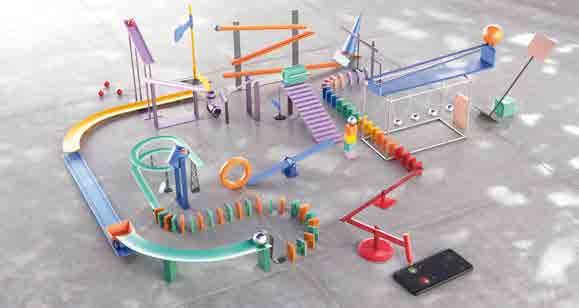
LET’S GET TO WORK!
Before you get started building your wacky contraptions, keep in mind that you can use supplies you find around the house. Most of the time, you won’t need to buy anything. Recycle, reuse, and repurpose things! Look through old toy bins, the recycling bin, and junk drawers for items that will make good building materials. See the resources at the end of this book for more ideas for supplies.
Check out this PBS video to learn more about simple machines and see them in action all around us. What are some examples of simple machines we use in everyday life?
WACKY CONTRAPTIONS
This book has many challenges for you to tackle, but they are just suggestions for being a contraption engineer!
You will likely come up with new ideas for challenges and elements to include in your contraptions. Write down your ideas in your engineering notebook and go for it! You are the engineer here.
Remember to start small. The challenges get bigger and bigger throughout the book. Don’t try to do the big ones first. You will learn as you go and your contraptions will grow as you learn. Also, building contraptions can get messy. If you do make a mess, be prepared to clean it up. Always ask for permission to do anything out of the ordinary and to use items that are not yours.
Essential Questions
Each chapter of this book begins with an essential question to help guide your design and creation of wacky contraptions. Keep the question in your mind as you read the chapter. At the end of each chapter, use your engineering notebook to record your thoughts and answers.
ESSENTIAL QUESTION
How does designing and building wacky contraptions use engineering principles?
Keep in mind, many of your contraptions won’t work right away. That’s okay! If your contraption doesn’t work, that’s an opportunity to think like an engineer.
Figure out why it doesn’t work. Pay attention to parts that did work. Then, redesign and retest.
Be wacky! Be creative! Be complicated! And most importantly, have FUN!
TEXT TO WORLD
What simple machines can you spot in your home or classroom right now? What purpose do they serve?
BALLOONS AND THE LAWS OF MOTION
Newton’s laws of motion are at work (and play) all around us every day, yet they may be hard to picture in your mind. It’s time to see for yourself how they work! This experiment will help you understand the forces at work when air is released from a balloon.
› For each balloon, thread the string through a straw. Tape the string to two anchor points, 10 to 15 feet apart and 3 to 5 feet off the ground. Make sure the string it tight.
IDEAS FOR SUPPLIES
• long, skinny balloons
• 10 to 15 feet of string for each balloon
• a straw for each balloon
• tape
• binder or bag clips
• timer
› Blow up a balloon about halfway but don’t tie it off. Use large kitchen clips or binder clips to keep the air from escaping.
› Carefully tape the balloon to the straw on the string. Pull the balloon back to an anchor point so that the open end of the balloon is closest to the anchor point.
› Unclip the clip and let go! Measure and record how far the balloon goes. How was the balloon’s movement an example of Newton’s third law of motion?
› Test Newton’s second law. How fast and far the balloon goes depends on how much force is acting on it and the mass of the balloon. Add more force than before by blowing up the balloon more. Does it travel farther? Measure and record how far it goes.
› Blow up the balloon just a little. Measure and record how far it travels. Compare the distance the balloon traveled in each of the three trials. What have you discovered about force and the second law of motion?
› Add mass to your balloon by taping objects to it (coins, popsicle sticks, paper clips). Test how far the balloon travels with different masses. What have you discovered about mass and the second law of motion?
Super Challenge
Redo this challenge and observe the speed at which the balloon travels depending on the force you apply and the mass of the balloon. Use a timer to measure how fast the balloon moves from one point to another under different circumstances.
